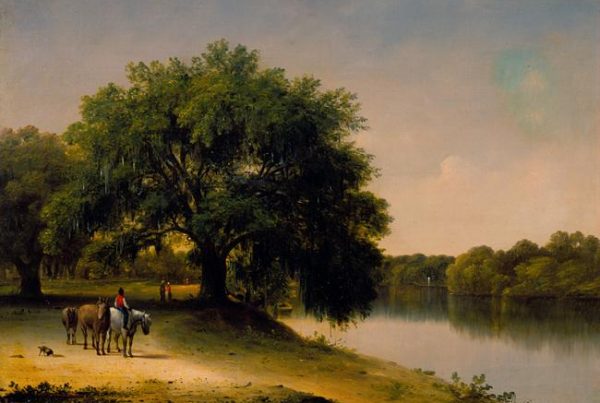My grandfather keeled over dead from a heart attack at the age of 54 after a long battle with arteriosclerosis. If you are not up on your medical jargon, that means the hardening of the arteries. I remember my parents’ telephone-the old black rotary dial type that weighed ten pounds and had a real metal bell-ringing obscenely early one Saturday morning when I was 5 years old. When the phone back then rang at that hour, bad news always followed. I remember hearing my mother stumble sleepily into the kitchen and pick up the phone receiver. All the fine Southern fried food my grandfather had eaten virtually every meal of his life had finally come calling. If there be a Southern Grim Reaper, he cometh not with a sickle but an order of onion rings to go.
While much of Southern cooking is susceptible to the regional stereotypes with which we Southerners are accustomed to dealing, the South has contributed an incredible amount of unique and mouth watering dishes to the world many times over. Whether that be Alabama whistle stop cornbread (disclaimer: if it got sugar, it cake…) to a pot of incomparable New Orleans-style gumbo to barbecue sauces and rubs of all types, the South is a veritable cornucopia of culinary faire. Southern cuisine can be notorious: big vats of oil with even bigger taste. All of which you take to heart-literally. The South survived on comfort food long before comfort food was respectable.
Where did all this Southern cookery originate? As with most things having to do with history and regionalism, the reality is far more complicated. There are many factors that go into regional dishes. The ethnic background of the people in a particular area plays a big role. For instance, in the hills of North Carolina where so many of the Upper South’s Scots-Irish ancestors came during the Colonial period, vinegar is very common. Many of our cousins still across the pond in Scotland to this day pride themselves on hand crafted malt vinegars.[i] This historical Scottish love of vinegar evolved particularly in modern barbecue sauces in that area.[ii]
The other major contributing factor to cuisine is the actual raw ingredients a particular region has to use for food. For many areas of the South that were impoverished, particularly after the War between the States during the Reconstruction period, pork became a staple meat because it was relatively cheap and abundant.[iii] Whereas, if one goes to Texas and asks for pork barbecue…well, let’s just not go there lest we mess with Texas.
As this article is not intended to be a historical tome on regional Southern cuisines, suffice is to say that each region, and even each particular dish, deserves its own historical research. The story of food is the story of humanity. Even as far back as Adam and Eve, the great Original sin in the Bible involved the eating of something in the Garden of Eden. Even in the Islamic Qur’an when the characters are eating or picking dates, that is a story telling clue to the reader that God is about to show up in some way.[iv] However one reads and interprets these stories, food often plays a central role in fable, myth, tale, and legend across all groups and religions.
Even though modern America has become increasingly secular, the one major religious-ish holiday that most people in this country can agree on is Thanksgiving. As is often the case, it is a holiday about Colonists to…wait for it…New England. Most kids, even in the South, no doubt have some memory of cutting out feathers and pilgrim hats for some grade school Thanksgiving lesson. Squanto saving the Puritans with a feast of thanksgiving. Charlie Brown. Turkey. Football. But what does the meta-message of modern American Thanksgiving revolve around? Food, of course.
This begs the question of what do we know about some of the earliest cooking in the Southern Tradition? Practical historians and modern archaeologists can tell us an incredible amount. Actually, the first Thanksgiving by Europeans with Native Americans was not on Plymouth rock but on what eventually became the Southern state of Florida by Spaniards in 1565 in St. Augustine,[v] but best of luck getting our Yankee cousins to ever admit that.
More specifically, the South actually had one this country’s earliest known celebrity chefs. In the early days of the rise of Andrew Jackson’s ascent to the Presidency, a woman named Mary Randolph, who had been born on a plantation just south of Richmond, published The Virginia Housewife: or, The Methodical Cook in 1824.[vi] To say this cookbook changed not only the South but the American culinary world would be something of an understatement. In what we would now call a best seller, Randolph’s cookbook went through 19 printings prior to 1860.
Modern readers take the lowly cookbook for granted in the 21st century, as any bookshop or online retailer has literally 1000s from which to choose. While the first known cookbook in English was written by the cooks in the household of King Richard II in England in AD 1390, the actual genre of the cookbook was a novelty for many centuries thereafter and largely existed only as a showpiece where powerful men could show off not only their books (a prized possession at the time) but also the extravagance of their household foodstuffs and their servants’ culinary talents in serving their master. Not until the advent of modern printery houses in 1700s England were cookbooks for the purpose of reference and teaching people how to cook became in any way practical for the common household.[vii]
What is unique about Mary Randolph’s contribution to Southern culinary culture is that she produced and curated a work that has a distinctly regional style that include recipes that seem to be influenced by Native American and African traditions, as well as reflecting her own roots from upscale Virginia. As Southern historian and food critic Cynthia A. Kierner writes,
Randolph presented a southern — specifically, a Virginian — model for southern readers. Although her occasional explanations of uniquely southern foods suggests she anticipated an audience beyond her region, [Randolph’s work] appealed to the women of the rural South who were the majority of her readers.[viii]
What immediately grabs the attention of a Southern scholar is the verbiage, particularly the first line of this excerpt, that Mary Randolph uses in her original preface. If ever there was a singular line that sums up the Southern credo of faith and family in relationship to and the role of the government, it is the following words:
The government of a family, bears a Lilliputian resemblance to the government of a nation. The contents of the Treasury must be known, and great care taken to keep the expenditures from being equal to the receipts. A regular system must be introduced into each department, which may be modified until matured, and should then pass into an inviolable law. The grand arcanum of management lies in three simple rules:–“Let every thing be done at a proper time, keep every thing in its proper place, and put every thing to its proper use.”[ix]
Mary Randolph, like many Southerners to this day, take this Jeffersonian view of practical but limited government: the government should resemble the family. For anyone who has had to suffer through family Thanksgiving meals that devolve into arguments and fights, suffice is to say that too much family and togetherness is a bad thing. Likewise, a government should be well run and financial sensible with the expenditure of funds, because the funds ultimately come the family and when mismanaged horribly hurt a family. The same is true with government: when it gets too big and out of control, bad things happen. If that is not the Southern traditional view of politics distilled into a simple cooking recipe, I do not know what is.
Aside from this discursus on the body politick, Mary Randolph’s cookbook truly is worth a perusal by foodies and history buffs. The work truly is a masterpiece assortment of surprising recipes of the culinary arts that one would not necessarily associate with the time period. The early 1820s is a bit of a forgotten era of American history, bookended between the closing of the august Revolutionary period and the soon to blossom Jacksonian revolution of the common man. In Randolph’s work, you get a taste of the Old Virginia of Jefferson governed by the well educated and wealthy planter elites with recipes like “An English Plum pudding” or “Partridges a-la-daub.” However, meals of the Jacksonian common man likewise abound, with entries like “tavern biscuits” and “catfish soup.”
Language, even Southern English, is a fluid entity. Words change meaning or become archaic over time. As with any work from almost two centuries ago, particularly one that deals with measurements, the terminology used in in Randolph’s book compared to modern cooking methods and recipes has changed somewhat. One will notice no temperature is ever given on how hot to set the oven, as the author assumes the cook knows how to regulate the fire burning in a hearth. If one wants to try one of the recipes, one has to use some common sense and “translate” the recipe into modern ovens and measurements. If one is not particularly adept at that, there is a recent cookbook available at any major online bookseller by Christopher E. Hendricks entitled Old Southern Cookery: Mary Randolph’s Recipes from America’s First Regional Cookbook Adapted for Today’s Kitchen that walks the modern cook through many of the original recipes with modern methods and tips.
Of course, some of Mary Randolph’s recipes probably are not all that palatable to modern tastes. Most folk nowadays would likely turn their nose up at a “mock turtle soup of calf’s head” or “lemon pickle” (that latter one also includes horse radish, garlic, and ginger!) I would personally not care for a beef marrow pudding made from stale bread and brandy, but it does have garnishes of citron and ginger over the top. If one were to serve it at a high class restaurant as “locally sourced, grass feed happy cows” and whole grain quinoa bread and garnish it with some sort of hippie kale, you might make a killing. Results may vary. Void where prohibited.
Many of the recipes, however, sound absolutely delectable. The whole section on ice creams are surprisingly contemporary. There is also an extensive section on marmalades, something that modern Americans have forgotten can be made from fruits other than oranges. As an experimenter of home brews like meads and beers, there are also some recipes for drinks of that nature, though most modern home brew methods use added yeast strains for fermentation now. And, wonder of contemporary wonders, in the recipe for lavender water, she even mentions using “essential oil of lavender.” As the Book of Ecclesiastes says, “there is nothing new under the sun.”
While Mary Randolph did not live long enough to enjoy the long lived fruits of her celebrity chef status, dying a scant four years after her masterpiece’s original publication, her work spawned several copycat cookbooks by the 1840s. Even today, many modern cookbooks follow her method of compiling, explaining, and categorizing recipes. Long before the rise of Julia Child and the modern celebrity chef, Mary Randolph stands as another testament of the Southern tradition’s ongoing contribution to civilization. Many of her recipes are still standards in many fine homes and restaurants all over the world, and are still as delicious as the day she first wrote them down.
***********
[i] https://www.taste-of-scotland.com/listings/orkney-craft-vinegar/
[ii] https://en.wikipedia.org/wiki/Barbecue_in_North_Carolina
[iii] https://www.southernliving.com/food/bbq/pulled-pork-bbq-evolution
[iv] https://www.muslimobserver.com/mentions-dates-quran-hadith/
[v] https://www.catholiceducation.org/en/controversy/common-misconceptions/the-catholic-origins-of-thanksgiving.html
[vi] For a readable online version, please visit: https://www.gutenberg.org/cache/epub/12519/pg12519-images.html, for a digitized scan of the last pre-war republished edition, visit: https://archive.org/details/virginiahousewif00randrich
[vii] https://bookriot.com/history-of-cookbooks/
[viii] Kierner, Cynthia A. (1998). Beyond the Household: Women’s Place in the Early South, 1700–1835. Cornell University Press. p. 282. ISBN 0-8014-8462-6.
[ix] Randolph, Mary (1824). The Virginia House-wife. Univ of South Carolina Press. ISBN 978-0-87249-423-7.
Postscript Bio of the Author: R. Ashley Hall was born and raised in Tennessee and has Bachelor’s degrees in History and Political Science and an M.Div. In Historical Theology. He currently resides in Nebraska.







One thing about our southern food culture is it is steeped in hard times. Rural southerners could take just a few simple ingredients and turn them into a really good meal. Or they would take something like a few squirrel and some left pork and turn it into Brunswick stew. The meal wouldn’t really have enough meat to feed everyone on a individual basis but in a stew everyone in a large family could have a little bit of meat in their bowl. Southerners have been blessed with the ability to turn a little into a lot for generations. I hope we dont lose it.